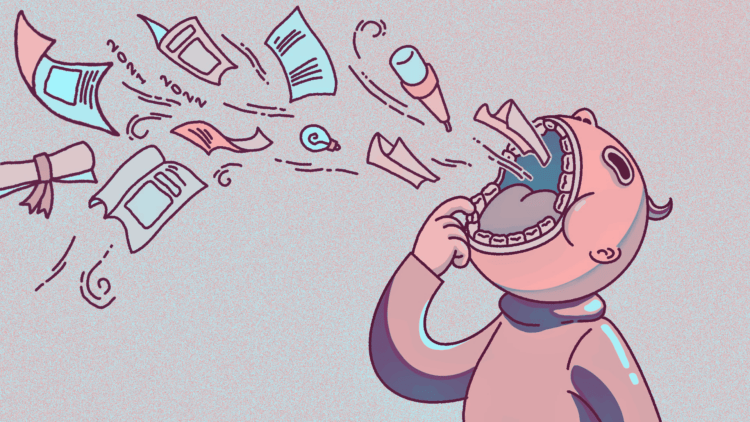In Defense of Video Off
Today is April 17, 2022. That’s day 766 (by some counts) into hybrid learning/working, a foisting of bodies in front of web cameras and into the tiles of a video conference.
We’re still figuring out how to do this. We know to laugh at ourselves when even, at this late date, we forget to unmute. Before logging onto a video conference lingers this question: “Video On or Video Off?”
Historically, I’m a Video On participant. I’ve learned to point the camera away from the bathroom and toward the neutral – no, academic – bookshelf.
But is this right? Is Video On a good expectation? In general, the answer depends on the circumstances. By day 766, most circumstances do not need Video On.
Advocates of Video On worry that non-video participants get distracted. This is a feeble argument. Regardless of video status, plenty of us manage to check email/socials/news/memefeeds. Marking instantaneous attention – by nods, smiles, and frowns – is shallow. We forget that a thoughtful question gives evidence for attention. The extent to which one pays attention is manifested in the long-term engagement, not by short-term performances.
Video On introduces new avenues of inequity. A dedicated web camera makes me look better than the person who’s got their phone camera propped up in the bathroom windowsill because that’s where the light is the best in their apartment.
Video On exhausts us – no one is surprised by a research team’s findings that “Using the camera was positively correlated to daily feelings of fatigue.” So too does Video On drain energy. Streaming video requires a lot of download data from the cloud, which has a little-appreciated and significant fuel cost. Server farms chug and sweat as it is, trying to keep pace with our Flix and Tube demands.
Video Off amounts to a phone call. For decades, people have conducted effective, high-stakes phone calls. Like world leaders, we’re capable of talking on the phone professionally or intimately, and we prepare for these interactions. I will sit at my desk with a notebook when conducting an interview, and I will fold laundry while chatting with my brother.
I like your face, but to be chained to the video frame should not become business as usual. Let me focus on your words instead of a Video On performance. And when Video On is necessary to critique and celebrate visual art, let’s treat it like a special occasion.
SAIC Gathers for the First of Three “Caste” Discussions
Thirty-six SAIC community members gathered to discuss the first part of Isabel Wilkerson’s “Caste: The Origins of Our Discontents.” Three panelists and an emcee, Delinda Collier, organized discussion. “Videos On, please.”
Payton Harris Woodard (MFA 2022) opened the discussion with Wilkerson’s description of “The Man in the Crowd,” a photograph from 1936 Nazi rally in Germany. A sole dissenter folds his arms and refuses to salute to Hitler. Harris Woodard asked, does one’s isolation make one liable to being discarded?
Kenneth Warren, University of Chicago professor of literature, noted that the popularity of the text does not come from its analytical quality. Wilkerson’s liberal mixing of similes makes for a confusing thesis. Instead, the book is useful for condensing a story that Americans want and need to know: The structures that uphold white supremacy and subordinate Blacks. Warren noted that Wilkerson does shine a light on the little-told history of Nazi leaders looking toward the U.S. for instructions on how to construct policies against the Jews.
Benjamin Melamed Pearson, Contemporary Practices Adjunct Professor, rounded out the panelist comments with insight into the role of visuality throughout the text. Looking at and looking away from phenomena informs action.
During the open discussion, folks were generally flabbergasted that Wilkerson made zero mention of capitalism in “Caste.” As put by Seth Kim-Cohen, this omission “seems impossible to me when considering all the things this book is writing about.”
Conversation returned to the photograph, “The Man in the Crowd.” The individual taking a stance against Nazism spotlights the heroic self. To suggest that individuality is the mechanism of resistance is a blind spot in the book: The heroic spotlight is an entrepreneurial impulse, which is a capitalistic impulse, according to book club participants.
Wilkerson would do well to think more systematically about approaching and remedying caste — or race relations — in the United States.
Disability Aesthetics Lecture Series hosts Georgiana Kleege
The webinar began with the emcee, Patrick Durgin, describing the video tile he occupied: a white man of middle age, nearly bald but wearing a hat, a bookshelf in the background. This description segued into Durgin’s praise for Georgiana Kleege’s critique of the ableist culture at the heart of visual culture.
Georgiana Kleege has been legally blind since age ten. She serves as a consultant to art institutions around the world in the development of programs for blind people.
As Kleege pulled up a powerpoint, she commented that this was an accessibility accommodation for the sighted people in the audience. “Sighted people need always to be looking at something,” or we will get anxious and alarmed. “Hence, powerpoint.”
Kleege’s work hinges on giving blind people access to works of art through touch. She said that she knows a lot of blind people are not happy with touch tours at museums. They feel too conspicuous, rushed, and unsure about what they ought to get from the experience. Kleege has developed programs that rely on verbal description of the art.
Sometimes called a haptic docent, Kleege touches art often. From her extensive experience, she’s found that the art tells you how to touch it. Some pieces invite delicate caresses, while some pieces provoke vigorous interaction.
Her projects exist in collaboration. Artists and long term project partners such as Fayen D’Evie create the touch-based art experience. Kleege’s touch projects have stretched from KADIST in San Francisco to the Mosesian Center for the Arts in Watertown, Massachusetts.
On Tuesday April 19, another Disability Aesthetics Lecture Series will feature poet Michael Davidson.
Michaela Chan (MFAW 2023) is a Video Off apologist this week.
























